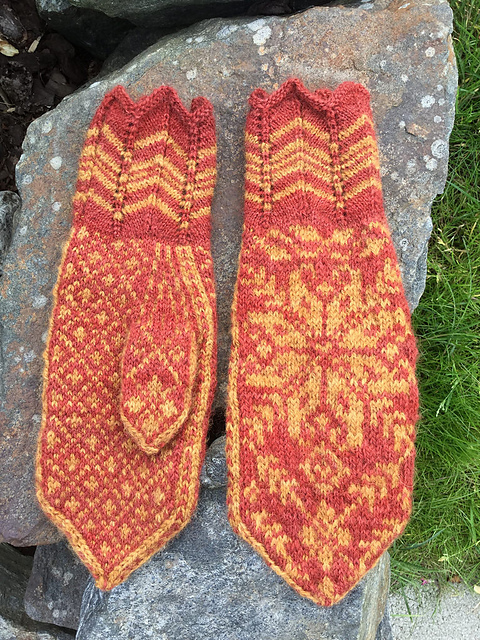 |
| Selbuvotter Pattern (Ravelry) |
The details of this pattern are similar to the mittens traditionally knit in Selbu, a municipality near Trondheim in Norway. As explained in the page I linked, they have a lace cuff, a repeating pattern for the palm and a centred motif or complex pattern that covers the back of the hand. There is a knitted border marking the transition from the palm to the back of the hand. The thumb starts narrow and grows in a gusset. It is like a miniature version of the mitten with its own fancy centred pattern on the outer side of the thumb and the repeating pattern from the palm on the other side, separated by the 3 stitch knitted border.
If knitting these by hand, you would definitely do them in the round. For machine knitting they need to be done flat, and although I suppose I could hand manipulate the lace, I am fine with ribbing.
I had to modify the pattern chart a bit for flat knitting. I added a seam stitch at each edge, attached the thumb gusset to the thumb instead of having it as an integral part of the mitten, and fiddled with the pattern to make it more symmetrical (centred on the palm). I also added some contrast stitches with the goal of reducing the number of long floats on the back.

Here are my modified charts (made in GIMP).
 Sorry they look so fuzzy; for AYAB each stitch is one coloured pixel so in original size they are microscopic.
Sorry they look so fuzzy; for AYAB each stitch is one coloured pixel so in original size they are microscopic.I decided that the 3 stitch border should be attached to the back of the hand as the decreases are made. I couldn't get my head around charting this in GIMP so decided to manually select the needles for this feature. It is not complicated, every second row the middle stitch is in the main colour.
Throwing caution to the wind I set off, making many discoveries about AYAB in the process.
- In hand knitting you knit from the right side but on the machine it is reversed. AYAB nicely flips the pattern automatically, making it imperative to remember which side the thumb is being made on. If knitting the chart as displayed above, the thumb has to be made on the left hand side of the needle bed. AYAB has a feature to mirror the pattern if you have already set up your knitting, as of course I had, with the thumb to be knitted on the right.
- I managed to knit up to the top of the main pattern, having taken the palm stitches off the machine once I needed to decrease to continue knitting them separately later. I made some mistakes in the border pattern but it looks decent. Continuing to knit the palm in the pattern was a challenge. I learned how to resume on AYAB, but managed to pick the wrong row to start on so there is a duplicate row there. It is hardly noticeable (I hope).
Here are some in progress photos. It is going well enough that I am encouraged to continue. I'm using junk yarn and the gauge is wrong but it is sort of looking like it could some day be a mitten.
 In the right hand photo, the orange line on the palm is the life line. You can see the duplicated row above it.
In the right hand photo, the orange line on the palm is the life line. You can see the duplicated row above it.I started the thumb (4 thumb stitches are on a safety pin in the photo at left) but that's when my head exploded. I'm going back to it now.















































